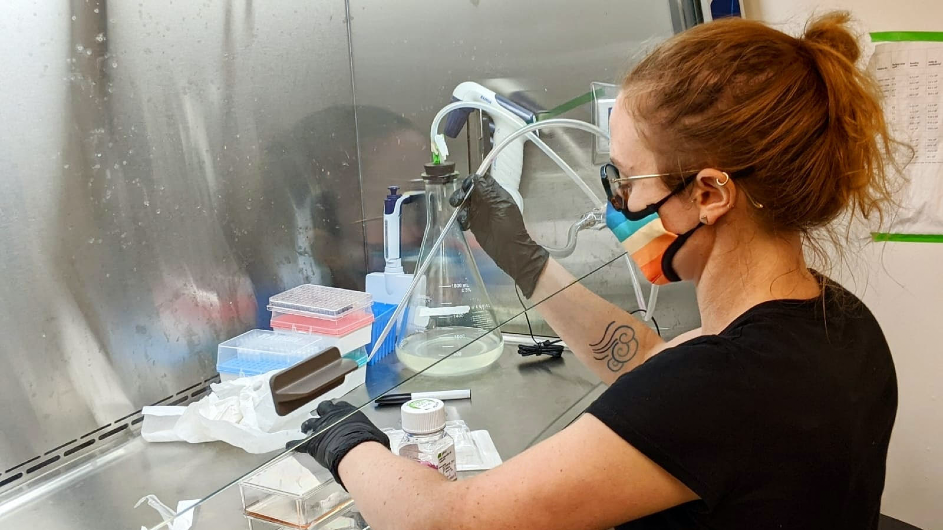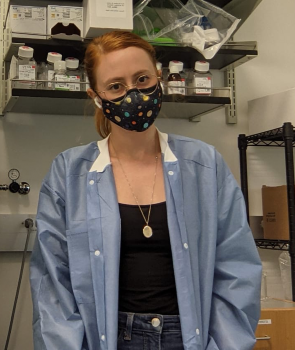Helping Bacteria to Help Us
Bentley Shuster, a postdoc, spoke about life in the lab and her attempts to program soil-dwelling bacteria to shrink tumors in mice.

This is part of a new series, "In the Lab," which introduces readers to the Columbia students, postdocs, and professors following their curiosity to learn something new about the world we live in.
At a bench cluttered with test tubes and microscopes, postdoc Bentley Shuster is analyzing Bacillus subtilis, a non-toxic bacteria commonly used as a model for studying its close relative, Bacillus anthracis, which causes the infectious disease, anthrax. Bacillus subtilis is safe enough to eat, and Shuster wants to learn if it can be used to deliver lifesaving therapeutics.

“I get frustrated when I hear people say the word ‘bugs’ to describe bacteria because it has a negative connotation,” she said. “But we wouldn’t be alive without bacteria! They help us digest food, fight disease, and protect us from harm. We should work with them because they work with us. They do amazing things that we can harness if we’re clever.”
The lab of Tal Danino, where Shuster works, is in the business of being clever in the search for ways to harness bacteria to fight cancer. Trained as a microbiologist, Shuster joined Danino’s lab to gain engineering experience and surround herself with both biomedical engineers and synthetic biologists. Danino’s side career making art was also a draw.
Most of Danino’s lab works on E. coli, a bacteria commonly found in the gut, while B. subtilis, the bacteria Shuster works with, lives mostly in soil. She’s exploring whether Bacillus can make and deliver anti-cancer molecules in animals—either by harnessing Bacillus strains in the wild or by reprogramming them in the lab as a potentially safer alternative to E. coli.

Outside of work, Shuster likes to play guitar, snuggle up with her dogs and a good book, and knit or crochet. The first in her family to graduate from college, she also makes time to mentor and encourage underrepresented kids who are excited about science. Columbia News recently caught up with her in Danino’s lab in the Northwest Corner Building.
What was your path to Columbia?
I studied bio at NYU, originally as a pre-med student, until I joined a research lab and learned what a PhD actually did. I’m a first-generation college student who had basically no knowledge of the college application process, let alone grad school. I got lucky with a few good mentors, and ended up in a PhD program in microbiology at NYU, where I studied the surface properties of B. subtilis. After grad school, I knew that I wanted to stay in New York. I found Danino's lab, which was a perfect fit since I wanted to transition to synthetic biology. It was also a huge plus that he’s into science art! I admire the way he uses art to communicate science to a broader audience.
What’s special about B. subtilis, the bacteria you study?
When they don’t have enough food to survive, they surround themselves in a protective coating to evade stressors like radiation, bleach, and crazy high or low temperatures. They basically hibernate, waiting for enough nutrients to wake them up. They can stay dormant like that for up to a thousand years and be revived in a simple petri dish. When dormant, they can survive almost anything that normally kills bacteria. A lot of work has gone into making sure B. subtilis can’t stow away on a spacecraft and colonize, say, the surface of Mars.
In the Danino lab, I’m trying to harness B. subtilis’s natural ability to incorporate foreign DNA into their genome to engineer them so they can make and deliver therapeutics to treat cancer. I work on B. subtilis because it’s easy to store in its dormant state, and safer than other bacteria commonly used in synthetic bio labs. The Japanese actually use B. subtilis to ferment soybeans in a popular dish called natto.
Microbes have evolved over billions of years to do some pretty crazy things, so I’m always trying to think of new ways to help them help us.
Why look for B. subtilis in the wild? Why would wild microbes in the soil make anti-cancer molecules?
Bacteria in the wild have evolved to live in a lot of different environments. They work within an ecosystem and can partner with neighboring organisms to improve their chances of survival. For example, bacteria in soil can secrete toxins to protect plant roots from competitive species of bacteria and fungi. It’s possible that a wild strain of Bacillus is already making a molecule that’s also toxic to tumor cells. And for us, it’s a lot easier to engineer B. subtilis to produce a toxic molecule naturally found in a related species than to try and engineer the bacteria to make an entirely synthetic molecule.
What’s the best part of working in the Danino lab?
It feels huge compared to my graduate school lab. I love that there are so many people to learn from and that I have skills to offer in return. Because one of our main goals is to treat cancer, the research is also rewarding. As a mentor, Tal is inspiring and he is also supportive of side projects. We spoke one day about cool applications for 3D printing with bacteria, and next thing I knew the lab had a 3D printer! We’re also encouraged to collaborate, which is refreshing in such a competitive field.
You started mentoring girls in STEM as a college student, why? What advice do you give them?
I wish I had had a female scientist to mentor me when I was younger. I’ve mentored a lot of female middle and high school students who were told they weren’t cut out for science, but are now grad students in STEM. It’s rewarding to see them overcome those hurdles. I emphasize to underrepresented girls, especially, that there isn’t just one type of scientist. Not every biology PhD got straight As in high school or followed a specific path. I tell them to take their time, follow their passion, and build a support network.
Failure is part of the scientific process, and we should embrace it. When setbacks feel personal, be kind to yourself! Physical, mental, and emotional burnout are real. Things that have helped me throughout my career: Finding a professor outside of my lab as a mentor, non-science-related hobbies, a good therapist, ergonomic pipettes, dogs, and a few amazing friends.
Advice for bioengineers generally?
No matter what you study, be able to communicate your science effectively to the general public. I used to practice all of my talks in front of my actress friend, or tell my mom about a day in the lab. Honestly, it’s pretty fun to talk science with your friends instead of the same 40 people at a conference.
What do you plan to do next?
There are plenty of applications for bioengineered bacteria beyond medicine. Engineered microbes could help us clean up the environment, for example. I’m currently working on a few side projects to explore this potential. We could use bacteria to speed up composting, break down pollutants, and even discover alternative energy sources. I want to take the skills I’m learning in Tal’s lab and find solutions for our planet. Microbes have evolved over billions of years to do some pretty crazy things, so I’m always trying to think of new ways to help them help us.